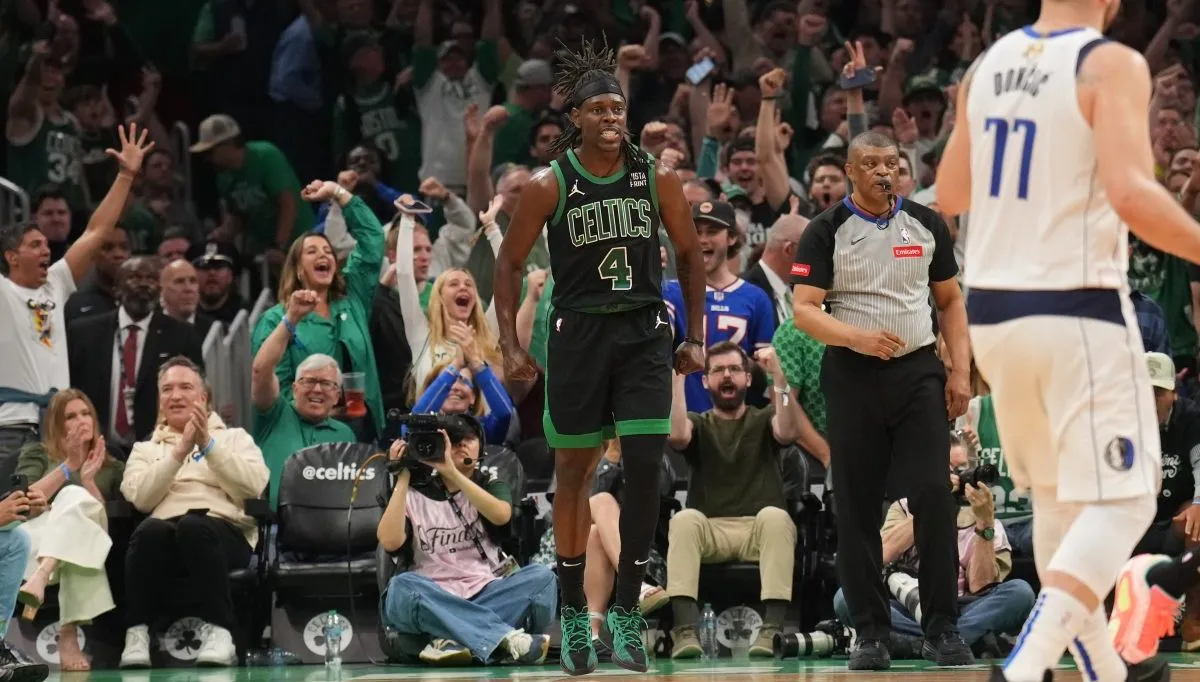All eyes are on Gordon Hayward Tuesday with a deadline for him to pick up the $34.2 million final-year option on his contract. For the Celtics, Hayward’s decision is the domino that should set their offseason maneuverings into motion.
Which is a good thing because Celtics fans, per offseason policy, are already getting anxious.
Less than 24 hours since the NBA’s trade restrictions were lifted, the Milwaukee Bucks beefed up their Eastern Conference-topping roster by paying a ransom for Jrue Holiday (a player previously linked to Boston) and poaching Bogdan Bogdanovic from Sacramento. The Bucks struck early and paid a steep price for Holiday but can now confidently put a supermax offer in front of Giannis Antetokounmpo having cobbled together a roster worthy of title contention.
Stay in the game with the latest updates on your beloved Boston sports teams! Sign up here for our All Access Daily newsletter.
Celtics Talk Podcast: Delaying the inevitable: Is Boston about to trade Gordon Hayward? | Listen & subscribe | Watch on YouTube
All this while James Harden reportedly tries to power play his way to creating a super team with Kevin Durant and Kyrie Irving in Brooklyn.
NBA trade rumors: Tracking all the latest news
Boston Celtics
Deep breaths, Celtics fans.
It’s still early. And so much of how Boston moves forward hinges on Hayward’s decision. A quick recap of Hayward’s potential decisions and what it means for Boston:
HAYWARD OPTS IN, WANTS TO RIDE OUT FINAL YEAR
If Hayward opts into his big final-year payday and expresses a desire to play out the season in Boston, the Celtics can move forward knowing the core of their team is intact. The danger for Hayward is that his future would no longer be in his control. The Celtics, if fearful that he was leaving after the season or simply not emerging as a legitimate contender this year, could deal Hayward during the 2020-21 campaign if an attractive deal materialized.
If Hayward is here and the Celtics are a clear-cut taxpaying team, the priority becomes improving on the margins. Boston must identify the best use of its three first-round draft picks.
Forsberg's Mock NBA Draft: Who will C's add in Round 1?
Is there someone at No. 14 that can contribute immediately like Saddiq Bey? Could the Nos. 26 and 30 picks be combined to chase another player in the teens with high upside like RJ Hampton? Could the Celtics move one of those late first-round picks and secure a more established bench option like Derrick Rose, who would provide necessary depth behind Kemba Walker at the point guard spot and offer a much-needed scoring punch?
Could Danny Ainge combine all those picks and vault high in the draft to obtain his most desirable draft target? The Celtics would also have the taxpayer’s midlevel exception available following the draft to pursue big-man help (Aron Baynes? Harry Giles?) or further bolster the bench.
HAYWARD OPTS IN, WANTS TO BE TRADED
Looking for the best of all worlds, Hayward opts into his big 2020-21 payday but expresses a desire to be traded for a fresh start. The Celtics would be under no obligation to comply and it’s a risky path for Hayward, especially considering Boston would lose a bunch of leverage in that scenario.
This is not an ideal path for either side but one that Hayward could pursue in hopes of the biggest overall payday.
HAYWARD OPTS OUT, WANTS TO RE-SIGN LONG TERM IN BOSTON
Now north of 30 and with an injury history, security could be important to Hayward. He can opt out of that bulky payday and take less first-year money to sign a long-term extension in Boston. The two sides would have to find a number that’s comfortable for both sides — no easy task, as Al Horford showed last year — but it could be beneficial for both parties. The Celtics would trim their salary commitment this season and lower their tax bill.
Report: Hayward still undecided as opt-out deadline looms
Part of the reason that we’ve heard so much about Hayward’s agent Mark Bartelstein canvassing the league for potential suitors is an attempt to gain leverage in that scenario. Bartelstein can go to Ainge and say, “Well, the Hawks are willing to pay, say, $90 million over the next three years, are you?”
It’s a dangerous game of chicken for both sides and if Boston is simply not willing to spend that sort of money, they can essentially challenge Hayward to take their best offer or sign elsewhere.
HAYWARD OPTS OUT, WANTS TO BE TRADED
If Hayward simply needs a fresh start but doesn’t want to leave Boston high and dry, he can opt out and work with the team to facilitate a sign-and-trade to his preferred destination. While the number of teams that can sign him via cap space is small and devoid of contenders, sign-and-trade options expand the pool of teams that could add Hayward by sending back assets to Boston.
There’s been no shortage of speculation about whether Indiana would be interested in bringing home their native son. At that point, Boston is trying to recoup as much value as possible while having to fill the void of a departing All-Star-caliber player.
HAYWARD OPTS OUT, WALKS AWAY
Maybe the worst possible avenue for Boston. It would be the third time in two offseasons that the Celtics would watch a max-salary player walk away for no return.
This seems like the most unlikely of options because of the lack of teams that can sign Hayward outright this offseason. Boston would remain over the salary cap and have limited means to replace Hayward.
Ranking top 25 free agents of the 2020 NBA offseason
The only benefit for Boston would be having the larger version of the midlevel as an asset during free agency but neither that nor the biannual exception would deliver the sort of impact talent that Hayward can be when healthy.


